Havanese Dog Breed Information: Facts, Traits, Pictures & More
When you purchase through links on our site, we may earn a commission. Here’s how it works.
The Havanese is a royal pup with a luxurious look. It’s easy to see why many Havanese owners worldwide fall head over heels in love with these tiny pups. Their beautiful silky locks and adoring personality are just a few of the many traits that we love about this breed. The Havanese is an energetic and intelligent breed which makes this pup a fabulous companion and a top-tier entertainer.
Table of Contents
Although they are wonderful family companions, they aren’t suited for every owner. They are quite needy and can suffer from anxiety if left alone for long periods of time. As a hypoallergenic breed, they are great for allergy sufferers and are also easy to manage in a multi-pet household.
So, whether you’re increasing your knowledge of all things dog or conducting some serious research for a Havanese housemate, this breed guide has everything you need. Let’s jump in and find out if this happy little pup is the perfect canine companion for you and your family.
History
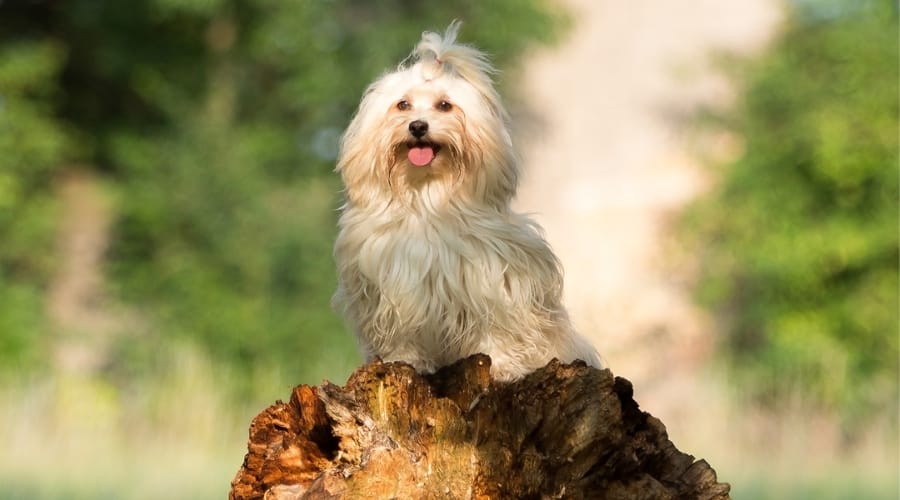
The Havanese is another breed from the ancient Bichon family ancestry, a genetic family of small white dogs. These types of pretty, lively lap dogs were exported around the world by sea merchants. They proved extremely popular with royalty and upper classes who owned dogs that served no operational purpose, just as a show of wealth.
It is thought that the initial ancestors were brought to Cuba by Spanish colonizers who claimed Cuba for themselves in the 1600s. Quickly gaining popularity with the Cuban Sugar Barons, they were bred with other small, aesthetically pleasing pups like Poodles, which refined the breed into the dog we know and love today.
In the 1959 Cuban revolution, those fleeing the communist takeover by Fidel Castro fled to the United States with their lapdogs in tow. It is now thought that the majority of Havanese pups in America have descended from just 11 dogs brought from Cuba. This means the gene pool is very tight.
Along the way, the breed has picked up a few different names, such as ‘Blanquito de la Habana’ or the Havana Silk Dog if you don’t speak Spanish. Or a more telling nickname is the Velcro dog due to their loyal and clingy nature that bonds to owners like, well, Velcro. A Havanese pup makes an awesome family pet. According to the American Kennel Club, he regularly ranks in the top 30 dog breeds in America and ranked 25 in 2022.
Temperament

The Havanese dog breed temperament is one of pure love. This is truly man’s best friend. They have gentle and very affectionate personalities that thrive on and crave human contact and interaction. So, if you’re after a doting doggy that loves to follow you around and allow you to spoil them at every opportunity, you’ve found it. A Havanese is a versatile family dog that has something for everyone.
You might think of this breed merely as a pretty lapdog but do not make this mistake. This is an extremely intelligent breed that will benefit from structured interaction and stimulation. Not just a cuddle and fuss. This is wonderful for you and the family, though, as they will be happy to entertain you with goofy antics and fun behavior all day long.
If it’s an independent dog that you want to allow you to get on with your day, this is not the breed for you. Left alone for too long or put out in the yard for hours on end, they will quickly become anxious and stressed. Most Havanese will suffer from separation anxiety if left for longer than a few hours at a time. This breed is intensely needy, hence the Velcro nickname.
Havanese are friendly with everyone. This makes them an optimal family companion. They are fantastic with children, too. So, if you’re too busy completing adult chores, they will happily join in with the kids for a game of hide and seek. You still need to supervise dogs with children, but the small size makes them ideal for kids of all ages.
These pups can be quite vocal about people in the yard, such as the delivery person or other animals passing by outside. Giving you a heads-up as to who’s lurking about. Just don’t expect them to pounce on any intruders, as they are more likely to roll over and ask for a belly rub. This is a terrible guard dog but a pleasant canine neighbor.
Size & Appearance
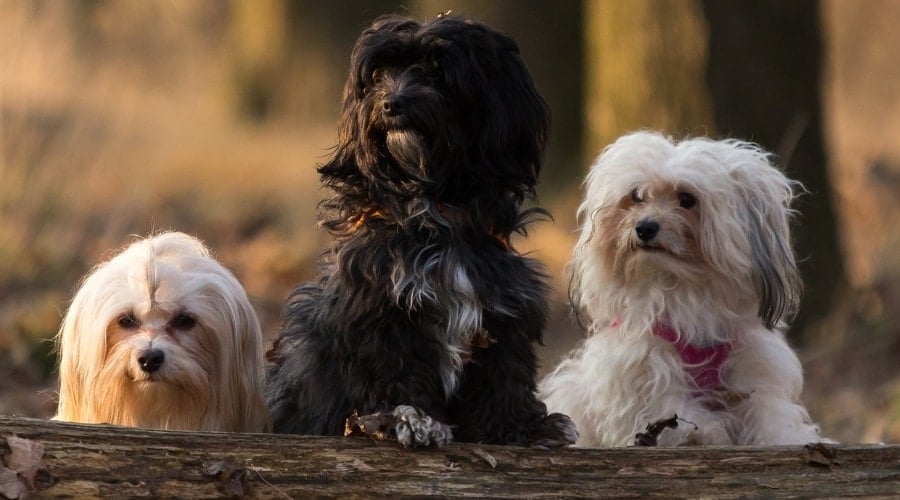
Wondering how big a Havanese gets? Classified as a toy breed by the AKC, Havanese are small in stature. Weighing in at just 7 to 13 pounds, they do not weigh much more than a small dumbbell. In stature, they measure only 8 to 12 inches tall. When fully grown, long hair untrimmed can fall down to their feet or be thick and curly. This gives the appearance that the body is fuller than it is. But this breed is quite tiny under all that hair.
Breed standard details an expression of softness, intelligence, and mischief. But with their large, dark brown, and almond-shaped eyes, they likely can get away with anything. The ears are long, floppy, and below the jawline, with the tail arched forward and up over the back. This pup has a springy gait and carries their heads with pride.
Coat & Colors
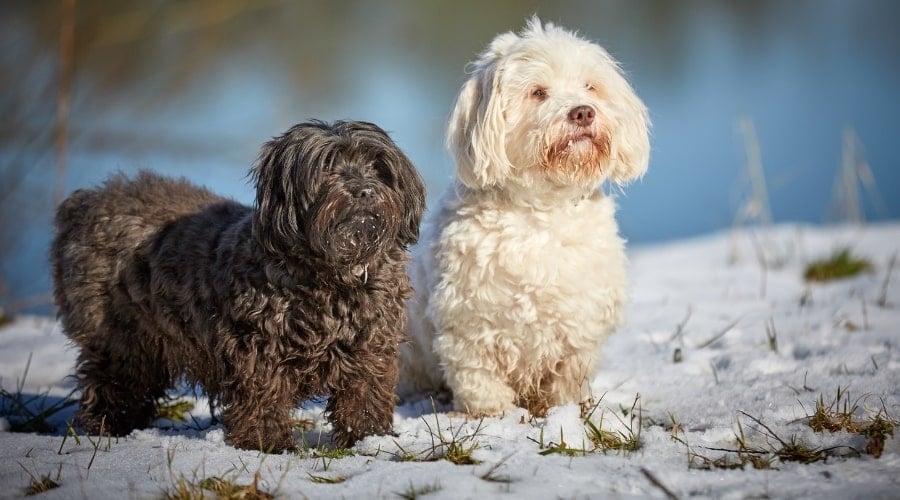
As a pedigree, the Havanese has a long coat that is silky, straight, and very soft to the touch. Different varieties of the breed can have short curly coats like the Poodle or even a wavy, wiry coat like a terrier. Long coats will have feathering hair on the ears, neck, legs, and tail, forming an all-around curtain of sorts. They can even develop into cords. When it comes to showing, any coat other than the long straight jacket is a disqualification.
Contrary to popular belief and appearances, the long silky coat is not built for warmth. It is a natural protection against heat and UV rays. Historically the breed has been acclimatized to hot, humid climates like that found in Cuba. So, his long coat is necessary and should not be trimmed.
When it comes to color, they will give you as much choice as you want. Havanese pups can come in white, black, black and tan, sable, gray, and pretty much every color in between. The coat color is of no importance when showing. All colors and patterns are permissible. The most common color is white and other light colors.
Exercise Requirements
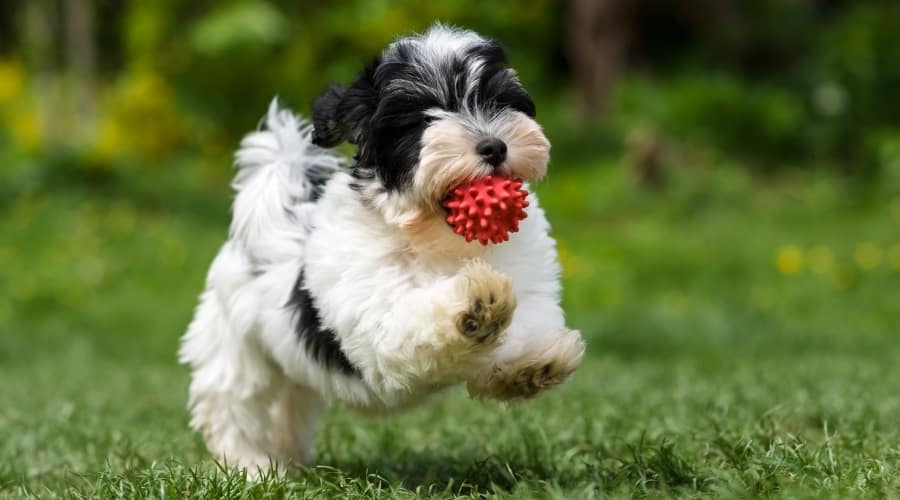
Unlike many toy breeds, the Havanese has a moderate exercise need, meaning 30 to 60 minutes of walks and playtime per day. The good news is that this tiny size means they can get that exercise at home, in the yard, as well as out and about. Plus, a good-natured game of chase, fetch, or a little rough and tumble will exercise them without it being time-consuming.
The Havanese’s adaptability to play and exercise anytime at any place makes them an excellent choice for families. Whether you are a couple on the go all the time or a young family with a busy schedule. Or even a retired couple with time on your hands, the Havanese will fit your lifestyle. When the weather is bad, or you really don’t have the energy to leave the house, having some interactive toys on hand will keep your pup busy.
Living Conditions
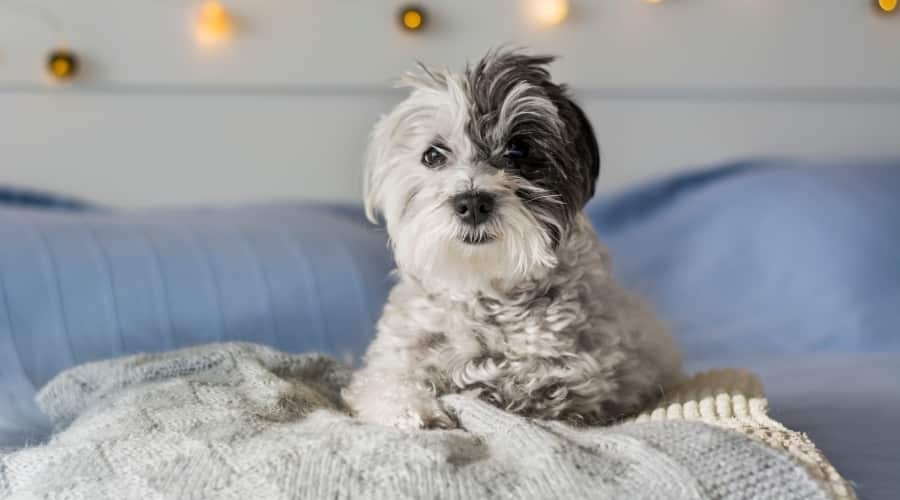
The Havanese is a perfect choice for apartment dwellers too. Compact and content with a calm environment and lots of cuddles, this breed doesn’t require a large yard or lots of outside time. As long they stay near you and get plenty of spoiling, they do well in an apartment. If you do have a yard, be sure to make it escape-proof. Although not prone to stray far, this breed does have a strong prey drive and will chase small furry things.
This calm and playful nature means they will love children and are small enough not to pose too much of a risk when it comes to knocking them over. Be sure to supervise children so that the Havanese does not get squished or pushed around too much.
Havanese dogs also live well with existing pets. Eager to please, they want to be everyone’s friend, whether that is a cat or dog. Just be mindful of their high prey drive if you have small animals such as gerbils or hamsters. They might think they are fair game for a chase and chomp session.
Training
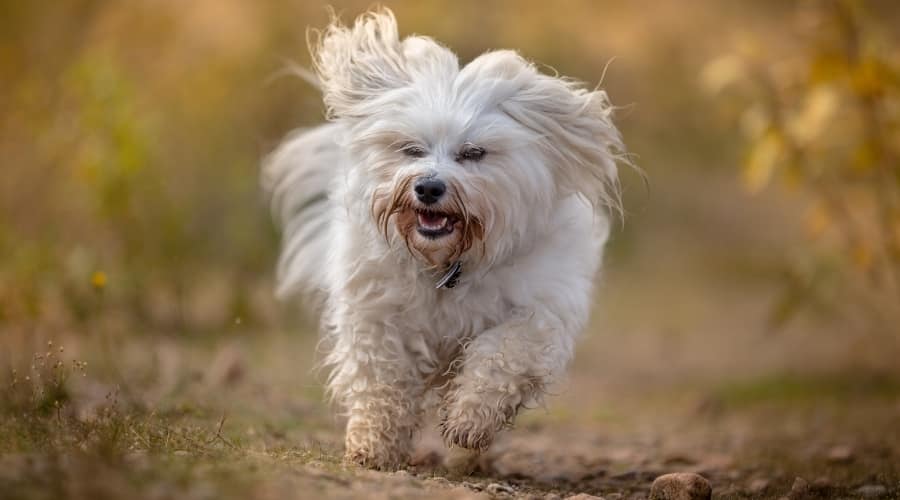
The Havanese thrive on human interaction. With a curious and intelligent mind, this breed is eager to learn and impress. This pup is a fast learner, happy to partake in simple commands such as sit, lie down, and rollover. As well as performing acrobatics such as dancing, walking, and jumping. The breed is also more than capable of taking on agility training and will undoubtedly excel.
This aspect of character makes the Havanese a suitable choice for newbie pup parents. Be careful, though, because the Havanese can be very sulky if scolded. So always use the positive reinforcement method as your primary training style. They are motivated by toys, treats, and praise, so be sure to mix it up to avoid them becoming potbellied or overweight.
Training isn’t just about tricks – socialization with other furry friends is a must. It will teach them how to behave with other dogs and build confidence so that this jumpy pup isn’t scared of its own shadow. The big wide world can be very daunting for a toy breed if they aren’t exposed to it and shown that it is theirs to explore and enjoy. Choose different dog breeds and sizes to socialize with so that they get used to all eventualities. But maybe don’t pair them with a Mastiff.
The Havanese will likely suffer from separation anxiety when left alone. You must account for this in training. Start by leaving them alone for short periods as a pup. And then build your absence up slowly to a few hours so that they get used to enjoying their own company. Crate training is another effective way to give them their own space and calm anxiety.
Health
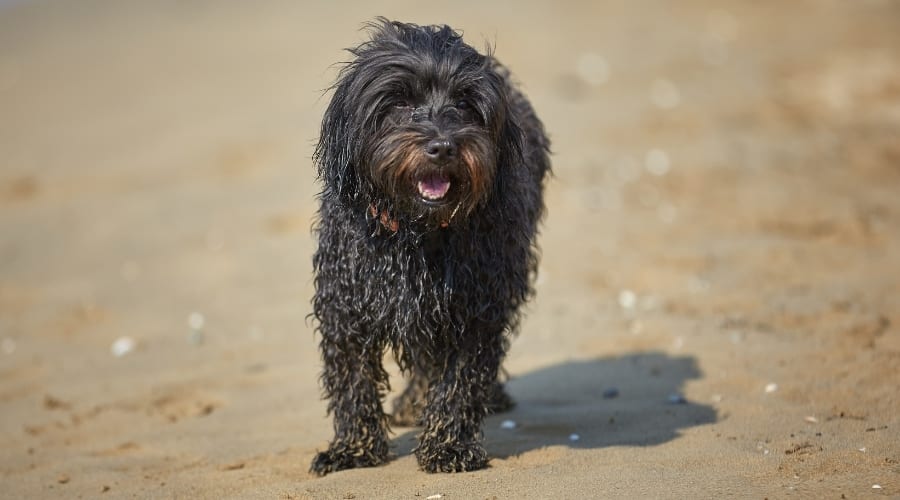
The expected Havanese lifespan is 14 to 16 years. So, be gratefully prepared for them to be with you for a long time. The best way to ensure they stay healthy is regular veterinary health checks, adequate exercise, and a good diet.
Overall, the breed is relatively healthy, with just a few common health problems. Below are the most common health conditions that affect the Havanese breed. This list is not exhaustive, but it is a great place to start.
Legg-Perthes disease: This is a deformity of the hip ball joint. Decreased blood supply to the femur bone causes it to die and then collapse. It causes deformity, pain, and sometimes lameness in the legs. It remains unclear if this disease is inherited or injury-related, but it can be treated.
Patellar luxation: This, essentially, is the term for a dislocated knee, and it can be common in toy and small-sized dogs. The patellar is the scientific name for the knee. During movement, the kneecap floats in and out of place, which can be very painful.
Eye conditions: The breed is prone to a variety of eye concerns. The most common condition affecting them is progressive retinal atrophy, which is slow-onset blindness. Cataracts are also common, which are cloudy spots that reduce vision.
Cardiac conditions: The most common concern is mitral valve disease. Affected dogs develop a heart murmur. Over time, the valve thickens and causes reverse blood flow back into the heart. This reduces the heart’s efficiency and eventually leads to heart failure.
Nutrition
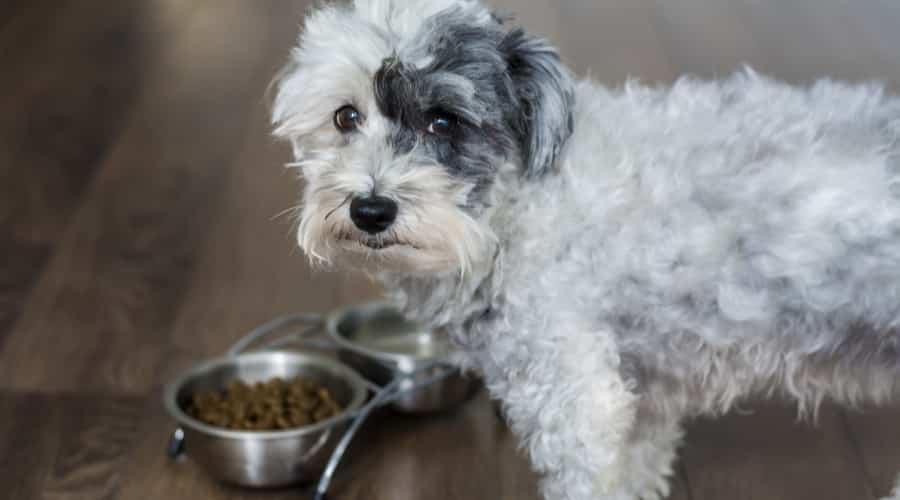
The Havanese will consume approximately one-half to one cup of food every day, dependent on size and weight. In addition, you should also account for exercise levels. Every dog is different, so be sure to consult food packaging for tailored advice and read our Havanese dog food guide.
While dry and unappetizing to us, a high-quality kibble will offer a well-balanced diet that meets canine nutritional needs. Always buy kibble that is specifically designed for a toy or small breed dog, especially as a small breed puppy. The crunchy bite-size pieces also help to break down plaque on teeth and massage the gums to prevent disease. If they get bored of kibble at any point, and Havanese are known to be a little fussy, try adding a little warm water or low-sodium broth to create a gravy for added flavor and moisture. You can also consider a fresh, human-grade option.
The Havanese has a healthy appetite for a small dog and is prone to obesity. Many of them lead a lap dog lifestyle and do not get enough exercise. Plus, they don’t have the self-control to say no or regulate their own food intake. So be sure to limit them to their recommended food allowance instead of free-feeding them.
Grooming
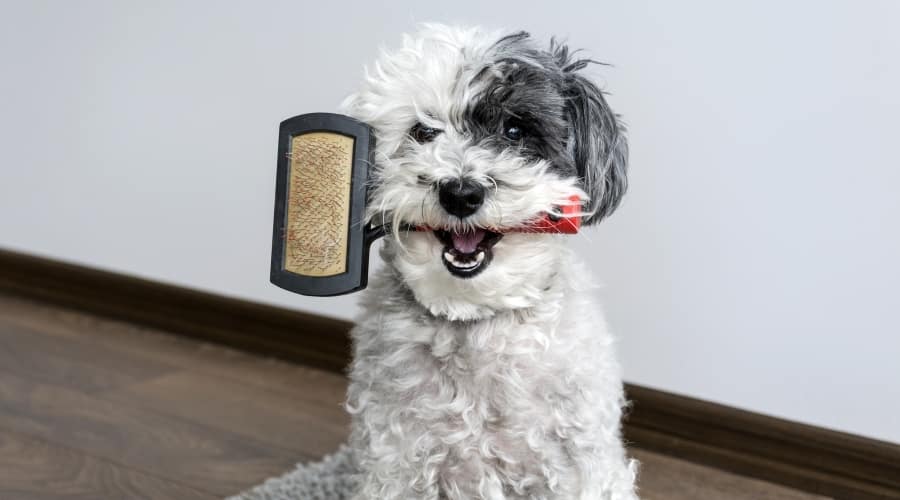
If you go for the pedigree long-haired Havanese, be prepared to become a grooming expert. Or at least shell out for one. Their long silky locks will need brushing daily to prevent knots and matting. Brushing can easily be done at home with a slicker brush, which stimulates hair follicles and promotes the natural oils that keep it glossy. On the fun side, the fringe of a Havanese can be bunched above the eyes with a clip to avoid eye irritation. Plus, it looks super cute.
Short-haired varieties of the Havanese will only need a quick brush twice a week. Brushing not only makes their coat shiny, but it also helps to remove dead hair and dirt. Whether long or short, the Havanese will be a light shedder, so there are fewer furballs to clear away throughout the year. Many owners will elect to shave their pups down with clippers during the summertime.
When it comes to bathing your Havanese, every 8 to 12 weeks should be ideal. They are relatively clean pups anyway, so unless they are smothered in mud or have rolled in something unsavory, avoid bathing too frequently. Otherwise, you wash away the natural coat oils that no amount of expensive shampoo can replace.
If you start your Havanese’s grooming routine at an early age, you should be able to clip their nails at home without any trouble. If active enough, the claws should wear down naturally, but if you hear them tapping on hard floors as they walk, it means they are too long. Brush teeth several times a week to keep periodontal diseases at bay.
Breeders & Puppy Costs
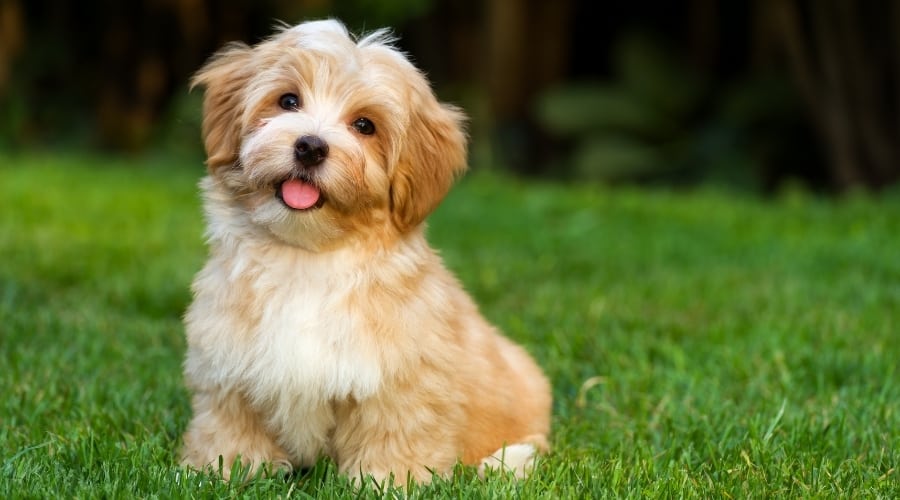
The Havanese is a popular breed in America, so tracking a pup down for your family shouldn’t be too difficult. The key is to find a reputable and trustworthy breeder well in advance of when you want your Cuban companion. If they are as good as they say they are, they will likely have a waiting list. The average price of a Havanese puppy from a reputable breeder is $1,000.
Good communication is a telltale sign of a breeder with experience. After the initial contact to order a puppy, they should talk you through the entire process from now to the birth and collection of your new pup. It is good practice to meet the parents and the puppies so that you can get a feel for your new pup’s likely temperament. Trusted breeders will also provide health certificates to evidence the health of their puppies. A great place to start your search is with the AKC’s list of registered Havanese breeders.
A poor breeder, or worse, a puppy mill, will try and entice you with low prices and be sketchy with the pups’ and parents’ details. Pressurized sales, poor communication, and tales of higher bids from other customers to bump up the price are all signs of irresponsible breeders. Please do not be tempted to buy a pup from a mill. You won’t be saving a life, but you’ll be getting a poorly doggy and fuelling the puppy mill business. Make sure you are prepared to bring your dog home with the perfect Havanese name.
Rescues & Shelters
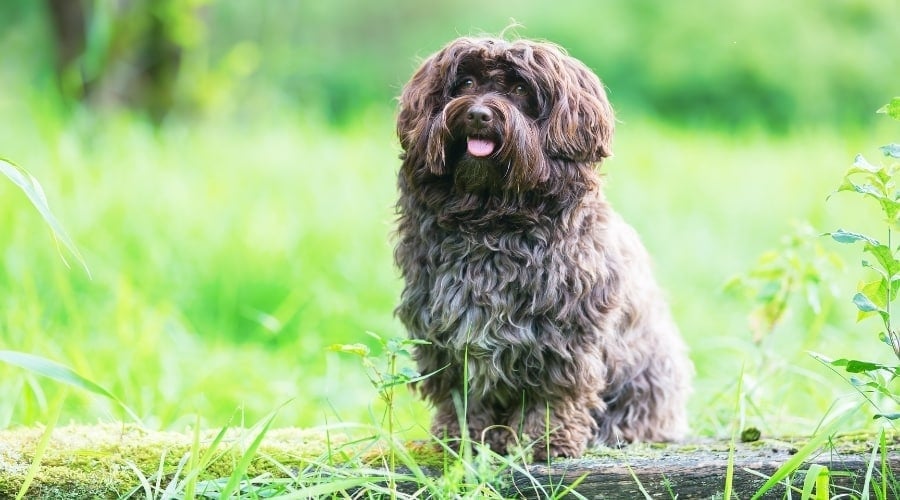
If you’ve never owned a dog before or are not sure about buying a puppy, you should also consider the ‘adopt and don’t shop’ approach. You could find a middle-aged Havanese that would not require the puppy-training investment of time. As well as giving an older pup a loving home.
If you are thinking about rescuing a Havanese, first visit your local rescue shelters. Even gorgeous pedigree breeds can end up here if someone has made an impulse purchase and regretted it. If there aren’t any locally, make friends with the staff, and they may be able to help you find a Havanese from another shelter. There are also dedicated Havanese shelter charities that specialize in rehoming Havanese. Rescue websites such as Havanese Rescue and Havanese Club of America are good places to begin.
As Family Pets
- Havanese are suitable for all types of families.
- This pup is happy to kick back or go all out on a short adventure.
- The Havanese is an active toy breed that needs 30 to 60 minutes of daily exercise.
- Ideally, they need owners who are home a lot or a so they are not alone for long periods.
- This breed’s nickname is Velcro, and they will be your shadow everywhere you go.
- These pups are great with kids and in multi-pet households.
- The Havanese is friendly with everyone and is not a guard dog.
- This breed is intelligent and trainable, making them a great option for first-time owners.
- These dogs are well suited to apartment living.
Final Thoughts
The Havanese is a people pleaser that lives for fuss and cuddles and a true lap dog that will unconditionally follow you anywhere. Whether you are a couple looking for your first fur baby or a family looking to complete your pack. Or a retired couple with time on your hands, this pup will fill that void seamlessly.
But, if you prefer your dogs to be less needy, this is not the breed for you. There is nothing independent about the Havanese breed. They have oodles of love to give and will smother you in it in exchange for just a small amount of food, company, and fun exercise. As an entertaining and gentle family pet, this pup is perfect. It’s clear to see why this tiny pup became the lapdog of choice for so many people and still is popular today.



